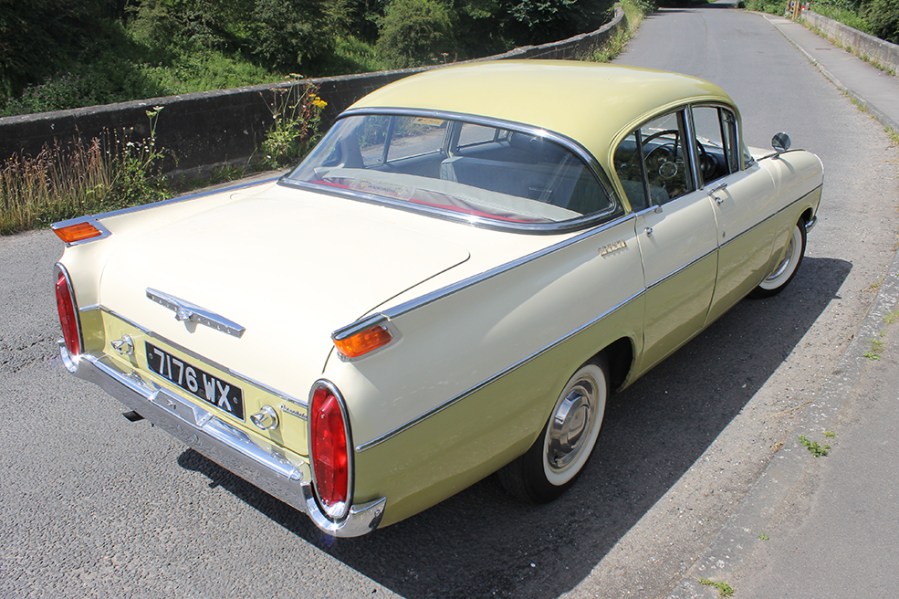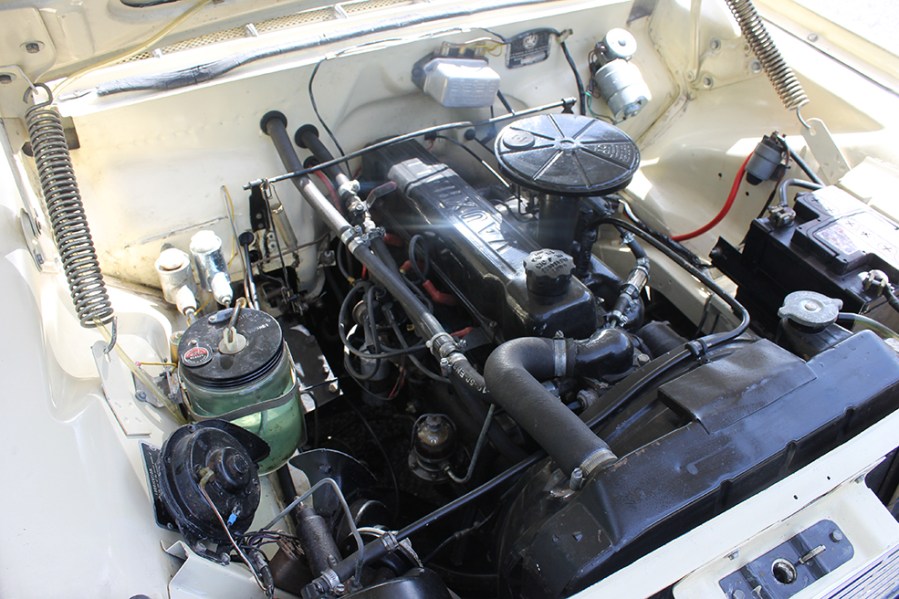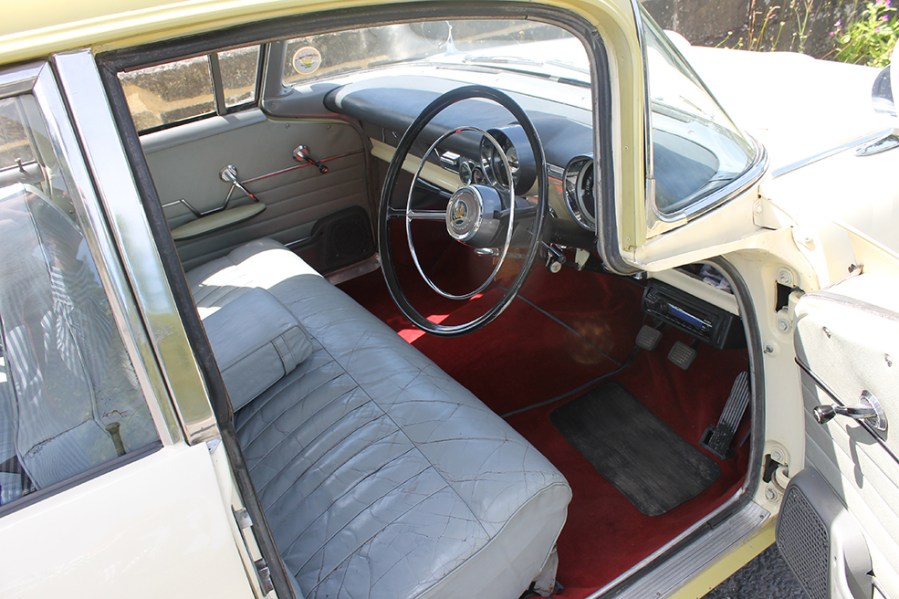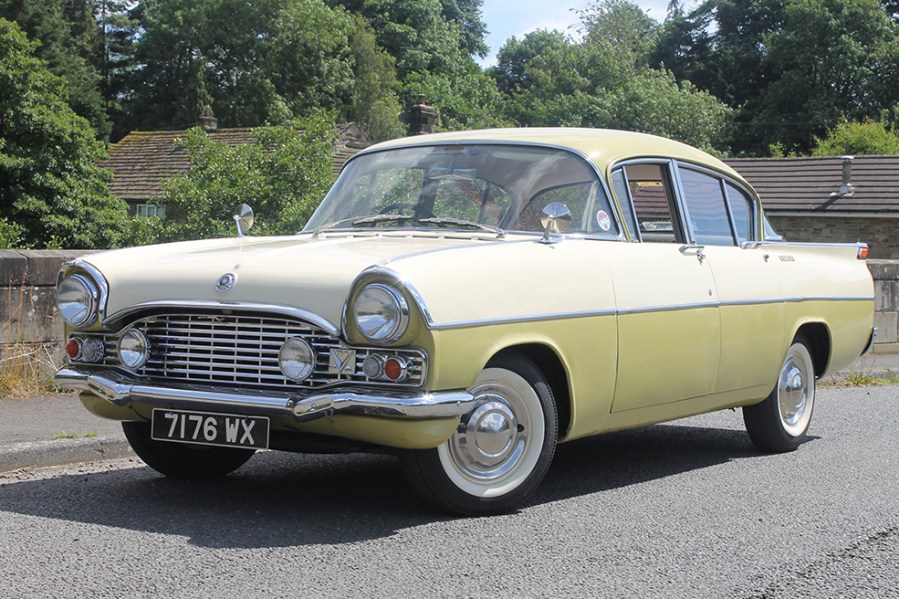With its US-styled wraparound glass, exaggerated fins and massive chrome bumpers, the Vauxhall Cresta is a fine example of 1950s British Americana
Words: Iain Wakefield
By the mid 1950s, a lot of fashion-conscious British motorists were looking enviously across the Atlantic at a host of large, sleek modern saloons that oozed gallons of American-inspired glamour. These stylish, bling-laden leviathans made family-sized cars built on this side of the pond look dreary in comparison. Although the sheer bulk of these models made them unsuitable for this island’s narrow roads, many were styled for the space age and offered more than their fair share of austerity-busting panache.
Anyone looking to buy a British-built car in the days before Russia launched its first Sputnik were faced with a very limited choice when it came to family-sized saloons. Although Ford set the big car market alight in 1956 with its ‘Three Graces’ – the MkII Consul, Zephyr and Zodiac – comparable offerings from other manufacturers were all rather boring and staid. Many featured interiors like a pre-war gentleman’s club clad with acres of wood veneer and leather, or were based on a stately pre-war design that looked more like a Second World War staff car than a top-of-the-range family saloon.
With rock-and-roll, coffee bars and space travel just around the corner, what the British car buying public needed was a brand-new range of family-sized saloons that reflected the optimism of the time. Britain entered the space race in 1957 with the commissioning of a radio telescope at Jodrell Bank and a few months later Vauxhall’s staid model lineup went into orbit that autumn when the Luton-based company unveiled its Buick Special inspired PA Cresta and its Velox-badged sibling on October 2,1957.
The PA Cresta replaced Vauxhall’s E-series model of the same name launched in 1951 and sold alongside the late ‘Forties introduced Velox. Both the E Cresta and Velox were powered by a 2262cc straight-six engine driving the rear wheels through a three-speed column change gearbox and this well proven power train was carried over to the 1957 launched PA S Cresta and PA D Velox models. A higher level of equipment and an optional two-tone paint scheme identified the PA Cresta over the entry level Velox and options across the range included a radio, external mirrors, reversing lamps, a locking fuel filler and overdrive.
The new PA Cresta and Velox were much bigger than their predecessors and with a column mounted gear change and full width front bench seat, Vauxhall’s new saloons could comfortably accommodate six adults. In 1958, ‘The Motor’ magazine tested a PA Cresta and commented that although the car was big, its size didn’t make it a nuisance around town and the tester summed up his report by saying how the new Vauxhall Cresta ‘offered a high level of refinement and passenger comfort’.

A single Zenith carburettor fuelled the PA Cresta’s 2.2-litre straight six and at 4400rpm this overhead valve unit could muster up a maximum of 78bhp and propel the car up to a maximum speed of nearly 90mph. Although not spectacular, these were reasonably respectable figures for a late ‘Fifties family saloon and a light-footed driver could squeeze 23.5 miles out of every gallon of Esso Extra squirted into the Cresta’s 10.8-gallon fuel tank, making this large, four-door, unitary bodied saloon by no means an expensive car to run.
Once on the move, the Cresta’s steering was light and responsive and although a little boat like at speed, the car’s road holding on a set of scrawny cross ply tyres was perfectly acceptable by the standards of the day for a car of this size. Upfront, both the PA Cresta and Velox benefitted from independent suspension consisting of coil springs, double wishbones, telescopic dampers and an anti-roll bar, while at the rear a live rear axle was suspended on semi-elliptic springs and kept in check by a pair of hydraulic dampers.
The Cresta’s braking system comprised of four hydraulically operated nine-inch Lockheed drums with a dash mounted handbrake operating on the rear wheels and was a virtually identical set up to the one fitted to the Velox. While both these cars’ underpinnings may have appeared standard fare for the time, it was the PA’s sleek, transatlantic-styled bodywork that really took the market by storm. Gone were the bloated looks of the E Series and in came wraparound screens (a three-piece affair at the rear), huge rear tail fins with built in indicators incorporated in the tips and a pair of heavy chrome bumpers complete with moulded overriders.
In late 1958, a Vauxhall PA Cresta saloon with manual transmission would have cost a cool £1073 (£358 of that sum would have been purchase tax). Rather than ordering a standard single body colour, adventurous owners could opt for a two-tone colour scheme in either pink and white, yellow and white or apple green and white and add a set of optional white-wall tyres. The Cresta’s transatlantic styling was complemented by up to the minute upholstery options that included a choice of two-tone leather, herringbone-weave nylon or Elastofab, a hardwearing vinyl-based material.
Britain entered the motorway age in 1958 with the opening of the Preston Bypass and the first section of the M1 between Rugby and Watford a year later. Cars like the long-legged PA Cresta and Velox became popular as high-speed long-distance cruisers and in August 1959 the Cresta received its first facelift. The revamp included a new, larger grille and the replacement of the three-piece rear screen with a single wraparound affair. Gone too was the car’s ribbed roof panel and this was replaced with a smooth version along with structural changes to the C-pillars and rear parcel shelf pressings.
Straight chrome side mouldings replaced the traditional Vauxhall flutes on the Cresta’s front wings and these decorative strips now formed the paint dividing point on revamped two-tone models. The similarly styled Velox also received a new grille and one-piece panoramic rear window. Under the bonnet, everything remained as before and any much-needed mechanical improvements to bring these models into the rapidly expanding motorway age would have to wait until the following year.
In August 1960 a larger capacity 2651cc straight six replaced the Cresta’s 2.2-litre unit. The larger unit featured bigger valves and power was now up to 95bhp at 4600rpm. Despite Ford offering optional disc brakes on the Zephyr and Zodiac, Vauxhall continued fitting drum brakes to the PA Cresta and Velox although the Vauxhall’s larger wheels now allowed bigger drums to be fitted. A Friary-built estate version was added to the line-up in 1960 and the more powerful range was now officially referred to as the Cresta PA SX and Velox PA DX.
Changes to the saloon’s body shell included a smaller pair of rear fins that now had a Vauxhall ‘V’ on each outer edge rather than the model’s trademark rear indicators. The PA’s distinctive rear indicators were now incorporated into redesigned, shallower lamp clusters stacked vertically above a higher mounted, straight-topped rear bumper. The only noticeable changes to the front of the car were to the sidelights and direction indicators, which from 1960 were now housed in a single unit. Inside, a redesigned facia included a ribbon speedometer that changed colour as the speed increased.
In 1961, Vauxhall’s Hydramatic automatic transmission was offered as an option across the Cresta and Velox range and for the final months of production, front discs were also offered as a cost extra option. The PA Cresta and cheaper Velox sibling remained in production until they were replaced by the squarer-looking PB series in October 1962. Although the PA Cresta was always considered an upmarket saloon when new (a Friary estate version was HM The Queen’s favoured mode of transport while she was at Sandringham), the PA series went on to pick up a reputation in the 1970s as the car of choice for aging Teddy Boys who wanted to relive their youth, an image that remains with the car today.

Bodywork
Despite over 173,000 examples of the PA Cresta and Velox rolling off the lines in the UK, Australia and New Zealand, the number of survivors remaining in a roadworthy condition today is extremely low due to the models tendency to rust just about everywhere, including the roof panel. One of the main areas where rust can work away largely unnoticed until too late is along the extensive seams around the front and rear panoramic screens.
This causes the rubber seals around the screens to eventually perish, allowing water to enter the car and play havoc with the floor pans, door pillars and sills. Rust also can also on the rampage underneath a Cresta too as the underside of these cars received very little rustproofing at the factory, leaving it to the dealer to apply a coat of underseal only if a new owner paid extra for it.
Over the years, rust may have seriously weakened the integral strength of the monocoque and poorly applied repair patches to get the car through yet another MoT may have trapped water behind them and made matters even worse. As these cars are starting to get expensive, watch out for examples that have been dressed to sell. When inspecting the bodywork, place a magnet on known problem areas such as wheel arches, sills and the tops of the wings.
If the magnet falls off in any of these corrosion ‘hot spots’, walk away from the car as any steel in these areas is long gone and has been replaced by a generous application of filler and goodness what else to strengthen what is basically a bodged repair. Also check the corners of the front and rear valances, boot floor and sides as well as the spare wheel well for any signs of advanced corrosion or poor repairs – and don’t forget to check for any missing chrome trim or badges as replacements can be hard to source.
Carefully check the base of each A-, B- and C-pillar, especially under the carpets, as any corrosion in these areas can be difficult and very expensive to repair properly. I can remember a friend rolling up to work in up in a newly acquired PA Cresta in the late ‘Sixties and on the way home the passenger’s door fell out complete with all almost all the A-pillar still attached by the hinges following a rapid stop at a set of traffic lights. Needless to say, my pal’s Cresta’s next journey was to the scrapyard’s weighbridge.

Engine and transmission
Vauxhall’s 2.2-litre straight six was essentially the same unit fitted to the E Series Cresta and Velox and over the years has proved to be reasonably hard wearing providing the servicing schedule has been maintained correctly. These engines produce lots of low-down torque and a PA Cresta in good order is quite capable of keeping up with today’s traffic on fast A roads. The 2.6-litre unit fitted to later cars makes for more refined cruising, especially if the car’s got the now very desirable optional overdrive.
A quick and easy way to check the health of a Cresta’s engine is to remove the oil filler cap and gently increase the revs. Puffs of blue smoke billowing out of the filler cap indicates either worn valve guides and/or bores and means an engine rebuild is due. While some major mechanical parts can be difficult to source, service items such as plugs, points and condensers are relatively easy to locate but beware of cheap foreign pattern parts. One of the best ways to locate parts for a Cresta is through a club like the Vauxhall Cresta Club (www.vauxhallcrestaclub.co.uk) which also has a page on its website where members can buy and sell parts.
The PA’s three-speed gearbox is fitted with synchromesh on all three forward gears. Overdrive has always been a desirable option and on the Cresta operated on second and third gears. If a gear becomes hard to engage, it’s usually down to worn bushes in the extended linkage connecting the column change to the gearbox. Any jumping out of gear indicates serious trouble with the gearbox and excess noise from the transmission will indicate worn bearings.
Carefully check the operation of the clutch as a worn centre plate is obviously an engine out job – that six-cylinder unit is very heavy and can be awkward to handle in a confined space. PA Vauxhall’s have a hydraulically operated clutch, so make sure there are no fluid leaks around the master and slave cylinders, as air in the system will make it difficult to engage gear. Very few Cresta’s survive with Hydramatic auto gearboxes and parts to repair a faulty unit are very hard to find.
Although propshaft universal joints can fail after a high mileage, rear axles are reasonably robust but excess oil leaking from the nose of the differential will indicate a failed oil seal and if left unattended will cause terminal damage to the bearings and gears. Worn bearings in the rear axle will make themselves heard by an ominous rumbling and worn half shaft seals will end up dumping the oil from the rear axle into the rear drums, contaminating the brake shoes in the process.

Interior and trim
Don’t be put off by a tatty interior if the car you’re looking at has a solid body and appears to be mechanically sound. Unfortunately, a new interior for a PA Cresta or Velox isn’t available off the peg, but a good trimmer will be able to recover tatty-looking seats and make up a new headlining, carpets and door cards in materials and colours very similar to the originals.
While this can be an expensive exercise, the club can sometime source bits of missing or damaged trim and locate hard to find second-hand parts. There’s a lot of painted metal inside a PA Vauxhall which should match the car’s body colour in most places, although some of the last Cresta’s off the line were fitted with a small amount of ‘wood veneer’ trim inside the cabin to enhance the car’s upmarket appeal.
Suspension, steering and brakes
There’s nothing too complex about the PA Cresta’s suspension set up and most parts can be obtained from specialist suppliers. When inspecting a Cresta or Velox prior to purchase, it’s very important to check the condition of the chassis where all the main suspension components are attached. This includes the rear rails where the spring hangers are mounted, as any corrosion in this area will be an immediate MoT failure.
Pay particular attention to the condition of the bodywork around the steering box mountings as corrosion in this area can go unnoticed and can be difficult to repair. Any perished rubber bushes such as those at the end the anti-roll bar can be replaced with polyurethane ones, although this modification can stiffen up the PA’s handling somewhat and spoil the car’s original and sometimes very entertaining road holding characteristics.
Most PA Vauxhalls will currently be running on a set of radial tyres but fitting these tend to affect the Cresta’s ride quality, which many enthusiasts consider an important feature of the car. Fitting a set of original spec cross plies certainly restores the PA’s handling characteristics, which will result in the car cornering with very little body roll accompanied by loud tyre squeal when pushed into a corner too hard. Also remember that later models had larger wheels to accommodate bigger brakes and fitting these to earlier cars will alter the overall gearing and give false speedo readings.

Vauxhall Cresta (PA): our verdict
There’s a lot to like about 50s motoring in 2022; the Cresta is a large car with old-fashioned controls that requires forethought and anticipation to drive well, but still offers a relaxing drive. It’s also comfortable and spacious, so a braver enthusiast could even run one as everyday transport. Parts supply is not as comprehensive as with some rivals – you’d be better with a Ford for that – but ownership incorporating DIY repairs and servicing is still just about doable today, particularly if you can embrace the second-hand market for more specialist items.
With only a very small number of PA Crestas managing to escape the banger circuit and the ravages of rust, prices for remaining examples in excellent or original condition can be punchy. Professionally restored cars are obviously going to cost more to reflect the amount of time and money spent reviving them. Expect to pay around £8000 to £10,000 for an excellent 2.2-litre PA Cresta, or more for a two-tone 2.6-litre model fitted with desirable overdrive. The few surviving Friary-converted estates in first-class order will change hands for whatever the owner demands. Projects and basket cases can be found at bargain prices but these are best left to those who have a love affair with their MIG welder and bottomless pockets.









